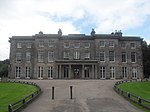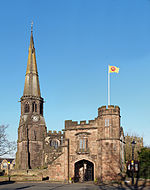Abram Council Offices
History
After significant industrial growth in the mid-19th century, largely associated with the coal mining industry, a local board of health was formed in 1880. The local board initially established its offices at Abram Brow, just off Warrington Road. Abram became an urban district in 1894 and, in this context, civic leaders decided to erect new offices on the east side of Warrington Road. The site faced a graveyard which included a memorial to the 75 men and boys who had died in a pit explosion at Maypole Colliery in August 1908.
The building was designed by Heaton, Ralph and Heaton in the Edwardian Baroque style, built in red brick and was completed in 1903. The design involved an asymmetrical main frontage of five bays facing onto Warrington Road. The central bay featured a doorway with an architrave and a keystone inscribed with the date of completion. The doorway was flanked by ornately carved columns supporting a cornice, above which there was a stone panel inscribed with the words "ADC Offices". There was an oriel window on the first floor and a small casement window in the moulded gable above. The left-hand outer bay contained a doorway on the ground floor and was fenestrated by an oriel window on the first floor and by a small casement window in the moulded gable above. The right-hand outer bay contained a doorway and a mullioned and transomed window on the ground floor, a pair of windows on the first floor and a small casement window in the moulded gable above. There was a prominent modillioned cornice above the first floor windows. Internally, the principal room was the council chamber, which hosted monthly meetings of the urban district council.
The building continued to serve as the offices of Abram Urban District Council for much of the 20th century, but ceased to be the local seat of government when Wigan Metropolitan Borough Council was formed in 1974. The building was subsequently sold to a developer, renamed "Maypole Hall" in recognition of the nearby pit where the explosion had taken place, and converted into apartments.
References
- ^ "Greater Manchester Gazetteer". Greater Manchester County Record Office. Places names - A. Archived from the original on 18 July 2011. Retrieved 29 March 2023.
- ^ Brownbill, John; Farrer, William (1911). A History of the County of Lancaster: Volume 5. Victoria County History. pp. 111–115. ISBN 978-0-7129-1055-2.
- ^ "A bit of old Abram". Wigan World. Retrieved 28 March 2023.
- ^ "Abram UD". Vision of Britain. Retrieved 28 March 2023.
- ^ "Ordnance Survey Map". 1914. Retrieved 28 March 2023.
- ^ "Maypole Pit Disaster". Liverpool Mercury. 22 August 1908. Retrieved 28 March 2023.
- ^ "Past Forward- 100th Anniversary of the Maypole disaster" (PDF). Wigan Heritage Service. August 2008. Retrieved 28 March 2023.
- ^ "Abram remembers pit disaster victims". Wigan Today. 20 August 2008. Archived from the original on 14 February 2016.
- ^ Pollard, Richard; Pevsner, Nikolaus; Sharples, Joseph (2006). Lancashire: Liverpool and the southwest. Yale University Press. p. 73. ISBN 978-0300109108.
- ^ The Municipal Year Book and Public Utilities Directory. Municipal Journal. 1957. p. 1003.
- ^ Local Government Act 1972. 1972 c.70. The Stationery Office Ltd. 1997. ISBN 0-10-547072-4.
- ^ "The old District Council Offices, Abram, Greater Manchester". Pictures of England. Retrieved 28 March 2023.


